The best sports logos are everywhere. They’re on jerseys, billboards, and even etched into our memories. They’re powerful symbols that represent history, identity, and emotion that we feel with our sports team.
Behind every great logo lies a blend of creativity, cultural significance, and strategy. Some of the best logos inspire fear, while others, like the Olympic Rings, unite billions globally. These sports team logos, whether simplistic or intricate, are crafted to last and evolve, just like the sports teams and brands they represent.
As you journey through this blog, you’ll discover the stories behind some of the world’s best sports logos. From their origins to their legacies, each design teaches us how to stand out, resonate, and endure.
And if these stories spark your creative side, you’re in luck—tools like the Arvin AI Logo Designer make it possible to craft your own timeless symbol, blending inspiration with innovation.
1. Olympic Rings
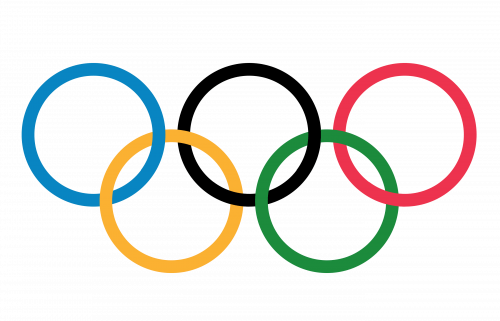
The Olympic Rings logo, created in 1913 by Pierre de Coubertin, symbolizes global unity and competition in the Olympics. It first appeared as a hand-drawn design on a letter by Coubertin, embodying the Olympic movement’s universality and the 5 different continents recognised by the Olympic Committee.
The current logo consists of five colorful rings interlocking, each in a distinct color: blue, yellow, black, green, and red. These colors and the white background represent those found on all national flags at the time. The interlocking rings symbolize the unity and connection of five continents (Africa, the Americas, Asia, Europe, and Oceania) through sport.
Coubertin himself explained the significance in the Olympic Review of August 1913, stating,
“These five rings represent the five parts of the world now won over to Olympism and ready to accept its fertile rivalries. Moreover, the six colors thus combined reproduce those of all the nations without exception.”
Dreaming of a logo as memorable as the Olympic Rings or the Jumpman? Let the Arvin AI Logo Designer help you create something truly unforgettable.
2. Vancouver Canucks
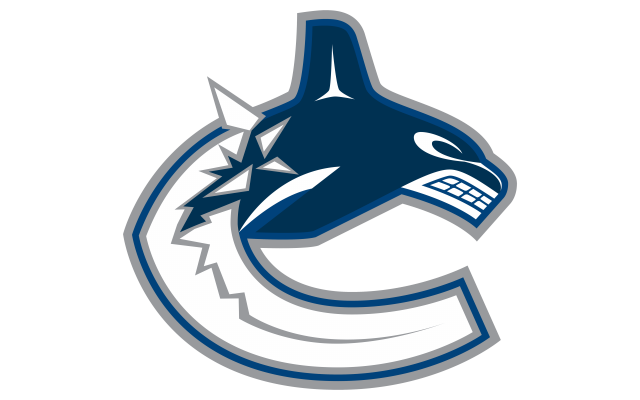
Now in 2025, Adam Foote and Manny Malhotra are finalists for Canucks coach. However long before this feud, the Canucks held a long history with their iconic sports logos.
The Vancouver Canucks’ logo features an orca breaking through an ice-shaped “C,” symbolizing strength, determination, and Pacific Northwest heritage.
The orca has deep significance in Indigenous cultures of the West Coast, often representing family, community, and protection. According to Spirits of the West Coast, the Native Orca Symbol conveys values of harmony, romance, longevity, and care. Orcas are believed to protect travellers and guide them back home, reflecting a communal and nurturing spirit.
This connection to Indigenous traditions ties the logo to Vancouver’s history and identity, a city on the orca-rich western coast. The design honours the region’s cultural and natural legacy, linking the sports team’s identity to community strength and unity, becoming one of the best sports logos created.
3. Milwaukee Brewers
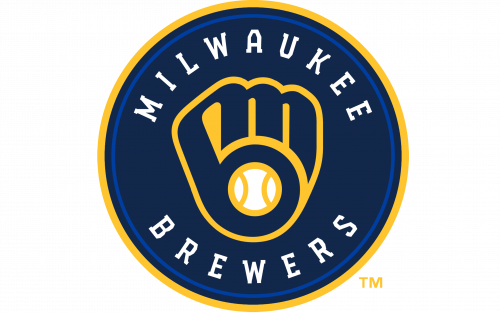
The Milwaukee Brewers’ iconic “ball-in-glove” logo is one of the best sports logos with a blend of creativity and subtlety, crafted by Tom Meindel in 1977. As a 30-year-old art student at the University of Wisconsin-Eau Claire, Meindel entered a team-sponsored contest to design a replacement for the “Barrelman” logo. His design ingeniously incorporated interlocking lowercase “m” and “b” letters, seamlessly forming the shape of a baseball glove. The Brewers embraced this emblem, which has since become a timeless representation of the sports team logo.
Elaine Meindel, Tom’s wife, was among the first to recognize the design’s brilliance, sparking “aha” moments for fans. Spotting the hidden letters in one of the best sports logos became a rite of passage for baseball enthusiasts of all ages. Former Brewers player Curtis Granderson, at 37, noticed the hidden elements while examining his cap, adding to the logo’s lore.
Erik Kratz, another Brewers veteran, compared the discovery to spotting the FedEx arrow, saying, “You’ll never unsee it again.”
4. Vancouver Grizzlies
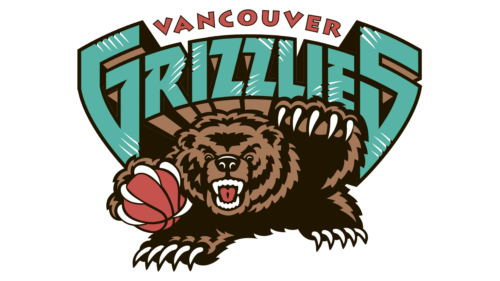
The Vancouver Grizzlies logo, introduced in 1995, represents the team’s identity. Designed by Josh Davis, it features a fierce grizzly bear clutching a basketball, symbolizing power and determination. Bold, angular “Grizzlies” typography in teal and black, with a curved “Vancouver” banner, reflects Canadian roots and British Columbia’s wilderness. This logo is one of the best sports logos, according to fans, due to the recognisability of the grizzly bear, making it one of the most recognizable logos of all time.
Bob Kerstein, then Chief Information Officer of the Grizzlies, modernized the sports team by creating the NBA’s first official team website in 1995. This groundbreaking move positioned the Grizzlies as pioneers in branding and digital outreach, as one of the best sports logos.
5. Utah Jazz

The Utah Jazz logo design by Thomas O’Grady in the 1990s reflects the team’s geographic and cultural connections to Utah. O’Grady, known for iconic NBA logos, drew inspiration from the Wasatch Mountains, Park City ski slopes, and Kennecott Copper Mine, celebrating Utah’s natural beauty.
The Utah Jazz logo, designed by Thomas O’Grady in the 1990s, represents Utah’s natural and cultural heritage. O’Grady, known for iconic NBA logos, drew inspiration from the Wasatch Mountains, Park City ski slopes, and Kennecott Copper Mine. The mountaintop in the logo mirrors the peak displayed on Jazz uniforms, symbolizing Utah’s rugged terrain.
As O’Grady further noted in an interview,
“Logos should evoke a sense of pride and identity not just for the team, but for the people who call that place home.”
6. Bullets
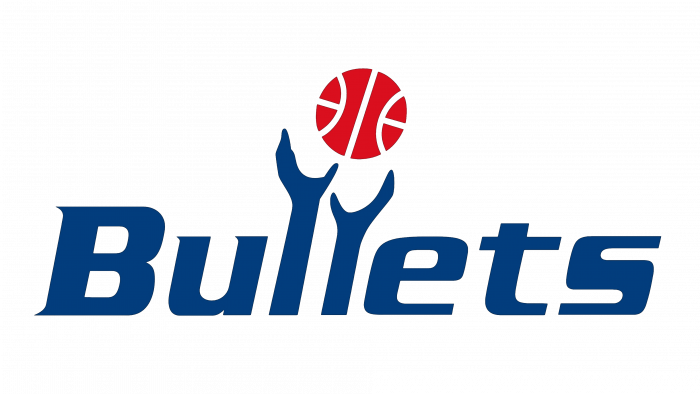
The logo design features “Bullets” in bold, dynamic typography, emphasising the team’s agility and speed on the court. Two outstretched hands replace the letter “L,” mimicking a pass or grab. A bright red ball above adds a vivid focal point, reinforcing the sport and connecting directly to basketball.
The flowing lines of the text are both sleek and modern, reflecting the fast-paced nature of basketball. The overall structure of the logo communicates action and teamwork, with the hands visually symbolizing cooperation and the pivotal moments of a basketball game. This element of fluidity and simplicity labels this sports team logo as one of the best sports logos for fans.
7. Miami Heat
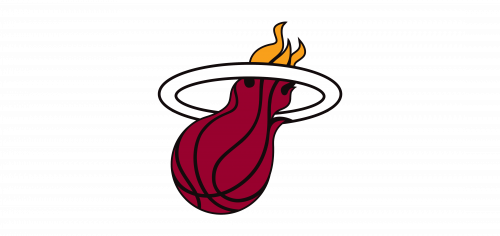
The Miami Heat logo is a dynamic and energetic logo design that visually encapsulates the team’s name and spirit. Designed by Mark Henderson and Richard Lyons, the logo features a flaming basketball, a striking representation of intensity and motion. The basketball is depicted in deep red tones with black contouring, giving it depth and a sense of realism. It trails vivid yellow flames, signifying energy, passion, and the “heat” the team brings to the court. The ball is designed to appear as though it is passing through a white ring, symbolizing a basketball hoop, adding context to the action-packed imagery.
This logo emerged as the winner of a fan-driven logo contest, receiving 34% of the votes out of 13,000 submissions, showing an instant connection with Miami Heat supporters. The choice of bold, contrasting colors, such as red, yellow, black, and white, creates a logo for easy recognition, as well as one of the best sports logos. The flames not only represent the Miami Heat’s fiery gameplay but also align with the vibrant, sun-soaked culture of Miami itself.
8. Paris Saint Germain (PSG) Logo
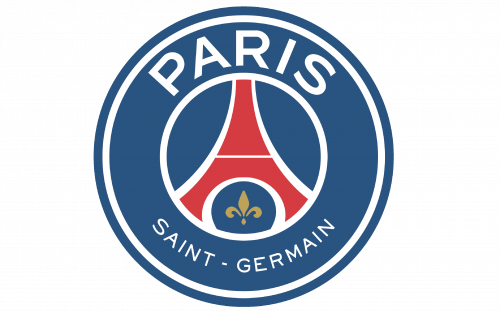
The Paris Saint-Germain (PSG) logo is a refined and symbolic emblem that represents the club’s rich heritage and connection to its city. Central to the logo design is a red silhouette of the Eiffel Tower, an unmistakable icon of Paris, set against a circular blue background. Beneath the tower lies a golden fleur-de-lis, a historic symbol often associated with French royalty and Saint-Germain-en-Laye, the city where the club was founded. This element signifies the regal and cultural roots of PSG.
Encircling the central elements, the name “PARIS” is prominently displayed at the top in bold white letters, emphasizing the club’s identity as a representative of France’s capital city. The words “SAINT-GERMAIN” are featured in a smaller font at the bottom of the circle, acknowledging the club’s full name and its broader historical context.
The choice of colors: blue, red, and white, not only mirrors the French flag but also embodies values such as pride, passion, and unity. The logo’s circular design ensures balance and symmetry, making it both modern and timeless across various formats, as well as being one of the best sports logos.
9. Detroit Red Wings
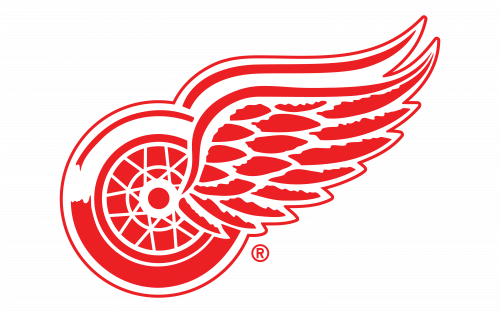
The Detroit Red Wings logo is one of the most recognizable and enduring symbols in professional sports. Featuring a detailed red wing extending from a spoked wheel, the logo design cleverly merges two key aspects of Detroit’s identity: its rich automotive history and the swift elegance of hockey. The wheel pays homage to Detroit’s nickname, “The Motor City,” a reference to its role as the heart of America’s automobile industry. The wing, on the other hand, symbolizes speed, agility, and motion, qualities that align perfectly with the sport of hockey.
Introduced in 1932 by James Norris, the team owner at the time, the logo was inspired by Norris’ time with the Montreal Amateur Athletic Association’s “Winged Wheelers.” He also wanted to pay homage to a hockey team for whom he had played earlier in the century, the Montreal Hockey Club nicknamed the Winged Wheelers. The Red Wings adopted this concept to create a unique identity for Detroit’s team. Over the decades, the logo has undergone only minor refinements, reflecting its timeless appeal and connection to tradition, and is one of the best sports logos.
From the industrial sophistication of the Red Wings to the energetic dynamism of the Miami Heat, Arvin AI can help you achieve perfection. Try the Arvin AI Logo Designer today!
10. F1
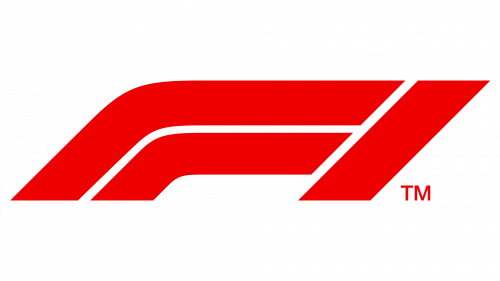
The Formula 1 logo, crafted by Wieden + Kennedy in 2017, embodies modern simplicity while capturing speed and precision. Replacing the original “flying F” logo design, it marked a new era under Liberty Media’s ownership. Two bold red lines and negative space form a dynamic “F,” evoking motion and a racing circuit’s flow.
Wieden + Kennedy, renowned for creative projects with Nike, Coca-Cola, Levi’s, and Old Spice, designed this forward-thinking Formula 1 logo. It maintains the sport’s legacy while emphasizing innovation. The sleek design seamlessly fits digital formats, merchandise, and branding, aligning with modern digital engagement trends in sports.
Sean Bratches, Formula 1’s Managing Director of Commercial Operations at the time, stated, “The logo represents Formula 1’s modern, dynamic direction, honoring its heritage while embracing innovation.”
11. Nike Swoosh
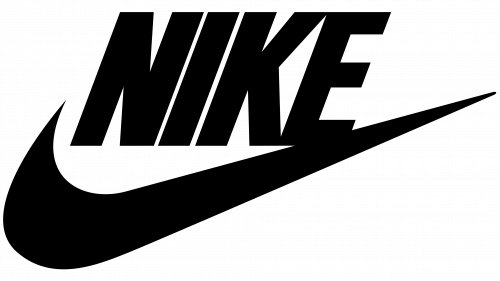
The Nike Swoosh, arguably one of the most recognizable sports logos in the world, was created in 1971 by graphic design student Carolyn Davidson. Tasked with designing a logo that conveyed motion and athleticism, Davidson developed the Swoosh, inspired by the wings of the Greek goddess Nike, who symbolized victory. This iconic logo captures the essence of speed, movement, and triumph, aligning perfectly with the brand’s athletic ethos.
The logo design itself is deceptively simple yet incredibly effective. The fluid, curved shape represents forward momentum and dynamic energy. Its clean lines make it highly adaptable across various media, from shoes and apparel to digital and print marketing. Originally designed for a mere $35, the Swoosh has since become a global symbol of performance, innovation, and determination.
Phil Knight, Nike’s co-founder, initially expressed reservations about the sports logo, famously saying, “I don’t love it, but I think it will grow on me.” Over time, the Swoosh has grown far beyond its initial impression, becoming synonymous with Nike’s “Just Do It” philosophy and serving as a cultural emblem for perseverance and success.
12. Air Jordan Jumpman Logo

The Air Jordan “Jumpman” sports logo, designed by Peter Moore in 1984, is a renowned icon in sports and fashion. Moore, Nike’s Creative Director, developed the logo for Air Jordan branding, inspired by Jacobus Rentmeester’s photo of Michael Jordan mid-air, showcasing his athleticism and “flight.”
The Jumpman logo was officially introduced in 1988 with the release of the Air Jordan 3 sneaker. It features a silhouette of Michael Jordan leaping in mid-air, legs extended, and a basketball poised in one hand.
Peter Moore initially designed Air Jordan branding with a ball-and-wings logo, reflecting Jordan’s nickname and high-flying style. Beyond the Jumpman logo, Moore also designed the iconic Air Jordan 1 and contributed to creating the Nike Dunk silhouette.
The Air Jordan logo transformed sports culture—what will yours do? Start building your legacy today with the Arvin AI Logo Designer.
13. Adidas Trefoil

The Adidas Trefoil sports logo, an iconic sportswear symbol, represents the brand’s legacy and commitment to style and performance. The famous three stripes originated in the 1940s with the Finnish brand Karhu Sports, which used them as a trademark. In 1952, Adidas acquired the rights to the three-stripe branding from Karhu for €1,600 and two bottles of whiskey, solidifying the stripes as its signature identity.
Adolf Dassler, the founder of Adidas, incorporated the stripes into the company’s branding when it was established in 1949. The design initially served a practical purpose, providing added stability to the shoes. The Trefoil logo, introduced in 1972, expanded on the three-stripe motif by integrating it into a clover-like design. Each leaf of the Trefoil represents Adidas’ focus on three major areas of performance: athletics, lifestyle, and outdoor activities.
14. Manchester United Logo
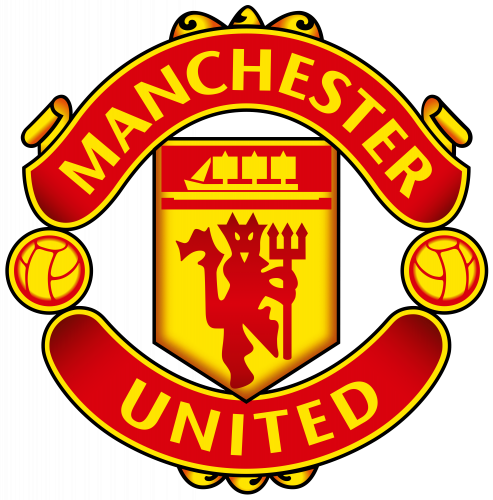
The Manchester United sports logo is one of the most recognized emblems in football, steeped in history and rich with symbolism. Its design has evolved significantly over the decades, with each iteration reflecting the club’s identity and heritage. The emblem draws inspiration from Manchester’s coat of arms, highlighting the city’s industrial and maritime legacy. The ship at the top symbolizes Manchester’s thriving trade via the Manchester Ship Canal, while the red devil at the center of the crest reflects the club’s nickname, “The Red Devils,” a moniker adopted in the 1960s under Sir Matt Busby.
The devil, holding a trident, was incorporated into the badge in 1973, symbolizing strength, power, and an intimidating presence on the football field. Surrounding the shield are two banners carrying the club’s name, “Manchester United”.
15. Dallas Cowboys Star
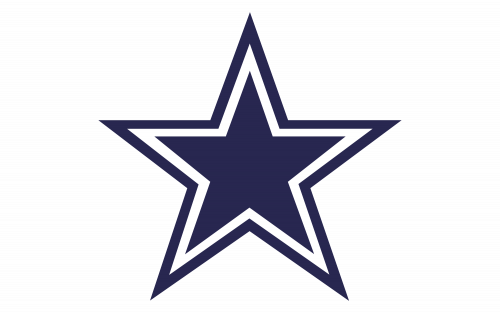
The Dallas Cowboys’ iconic star sports logo is a simple yet powerful representation of the team’s identity and legacy. Introduced in 1960 when the franchise was established, the five-pointed blue star symbolizes Texas’ nickname as “The Lone Star State,” reflecting pride, independence, and unity. The star’s design features a bold navy-blue outline with a white border, emphasizing clarity and visual impact.
Over the years, the logo has undergone minimal changes, retaining its original design to maintain its recognition and connection with fans. Its simplicity has contributed to its status as one of the most enduring and universally recognized symbols in American sports.
Jerry Jones, the Cowboys’ owner, once remarked,
“The star isn’t just a logo; it’s a beacon. It represents a legacy that transcends football, connecting generations of fans across Texas and beyond.”
16. New York Yankees
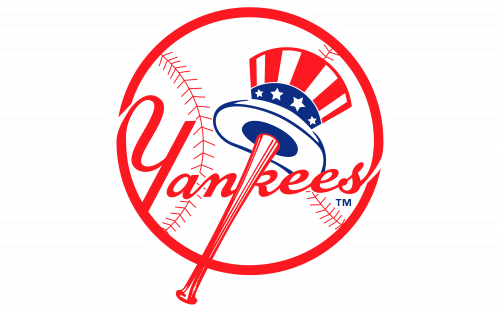
The New York Yankees sports logo is one of the most iconic symbols in sports, representing not only a baseball team but also a cultural phenomenon. The circular logo, introduced in 1947, features the word “Yankees” written in a flowing script, with the “k” forming the shaft of an Uncle Sam top hat. This hat has white, blue, and red colors adorned with stars, sitting atop a baseball bat that replaces the vertical stem of the letter “k.” The entire composition is encased within a red circle, with red baseball stitching running along the edges, symbolizing the sport’s heritage.
Designed to emphasize patriotism, the logo reflects the Yankees’ status as America’s team and their strong connection to New York City’s rich history. The Uncle Sam hat represents national pride and unity, tying the Yankees’ identity to a broader American spirit.
Its simple yet powerful design resonates beyond sports, often seen as a fashion statement and a symbol of New York’s enduring legacy.
17. Chicago Bulls Logo
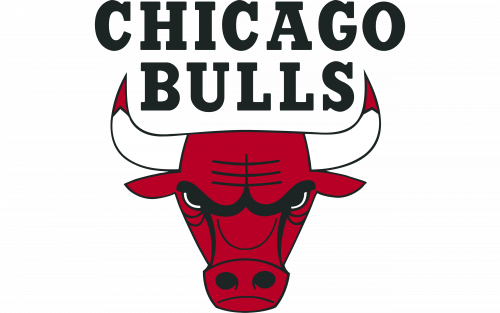
The Chicago Bulls sports logo, created in 1966 by Chicago-based designer Dean Wessel, is a globally recognized symbol of power and toughness. It features a bold red bull’s head with sharp horns, flared nostrils, and menacing eyes, capturing a fierce competitive spirit. The all-caps “CHICAGO BULLS” typography above the head complements the aggressive imagery with its bold simplicity.
The Chicago Bulls logo uses a red, black, and white color scheme to represent strength, aggression, and dominance—key traits of the team’s identity. The bull symbolizes Chicago’s history as a major meatpacking hub, reflecting its ties to the stockyards and the city’s nickname, “Hog Butcher for the World.”
Jerry Reinsdorf, the Bulls’ owner during the team’s legendary 1990s dynasty, once said, “The logo stands for more than a basketball team. It represents Chicago grit, perseverance, and the will to win.” Its consistent design, unchanged since its inception, has become synonymous with the team’s global brand, which skyrocketed during the Michael Jordan era.
18. Albuquerque Isotopes Logo

The Albuquerque Isotopes sports logo combines playful design and scientific symbolism to reflect the team’s unique name and origins. Inspired by the world of atomic energy and the iconic animated series The Simpsons, the logo features a stylized letter “A” at its core, representing Albuquerque. Surrounding the “A” are orbiting atomic pathways, complete with electron-like spheres, which reinforce the scientific theme tied to the term “isotopes.”
The color palette is vibrant, utilizing shades of red, orange, and yellow to create a fiery and lasting impression, symbolizing both the heat of Albuquerque and the explosive excitement of baseball. The typography for “Isotopes” is dynamic and slightly irregular, evoking movement and energy, further aligning with the atomic theme.
The team’s name and sports logo were inspired by The Simpsons episode “Hungry, Hungry Homer,” where Springfield Isotopes considered moving to Albuquerque. This pop-culture reference shaped the Isotopes’ branding, making them a standout in Minor League Baseball for creativity and cultural relevance. Todd Radom called the branding “an ingenious blend of science, humor, and community identity that captured fans’ imagination.”
19. Premier League Lion
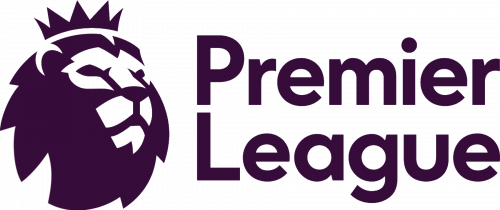
The Premier League Lion sports logo is a modernized interpretation of a longstanding emblem symbolizing power, pride, and authority. Introduced in 2016, this redesign marked a departure from the detailed, traditional lion crests of the past, opting for a minimalist, contemporary style that aligns with the league’s global branding efforts. The lion’s head, crowned to signify excellence and dominance, is depicted in a bold, geometric design, using clean lines and sharp angles to create a striking, memorable silhouette.
The logo employs a monochromatic purple color scheme, which is both regal and distinct, setting the league apart from other soccer competitions. The typeface used for “Premier League” complements the lion’s modern aesthetic with clean, sans-serif lettering.
The design, by DesignStudio and Robin Brand Consultants, aimed to create a logo adaptable to evolving digital platform demands. Richard Masters, former Premier League managing director, called it “a bold step forward, reflecting modern, global competition while preserving the lion as core.”
20. Altoona Curve Logo
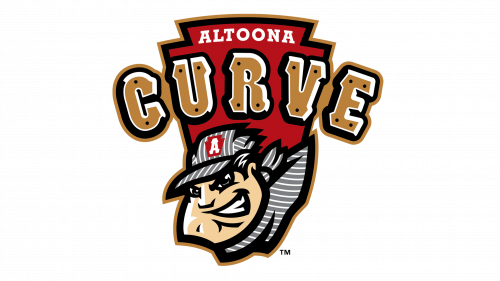
The Altoona Curve sports logo embodies the spirit of baseball while paying homage to the rich railroading history of Altoona, Pennsylvania. The design features a bold, animated figure of a train engineer, complete with a determined expression and a classic striped cap adorned with the letter “A.” The central character reflects the city’s heritage as a hub of railroad engineering and innovation, tying the team’s identity to the local community’s historical roots.
The wordmark “Curve” features a bold, dynamic font with a slight arch, reflecting curving railway tracks and the curveball. A smaller banner with the team’s full name, “Altoona Curve,” highlights regional pride. The earthy tones of brown and gold, paired with bold red, evoke tradition and energy.
21. Invictus Games Logo

The Invictus Games sports logo stands as a beacon of resilience, hope, and determination. It features bold uppercase lettering in grey and vibrant yellow, with the letters “I” and “A” highlighted in yellow to emphasize the phrase “I AM.” This element connects directly to the Games’ inspirational motto, derived from William Ernest Henley’s poem Invictus: “I am the master of my fate, I am the captain of my soul.” This subtle yet powerful design choice encapsulates the indomitable spirit of the athletes who compete in these games.
The clean, sans-serif typeface gives the logo a modern, approachable feel, while the contrast of grey and yellow symbolizes strength and optimism. The design is minimalist yet impactful, ensuring that the message of empowerment and inclusivity resonates.
Prince Harry, founder of the Invictus Games, highlighted the significance of the logo during the event’s launch, saying, “This logo is more than a design—it’s a statement of identity for every competitor. It tells the world: ‘I am here, and I will not be defined by my injuries.’”
22. Tour De France

The Tour de France sports logo is a dynamic and playful design that perfectly captures the essence of the world’s most prestigious cycling race. Designed in 2002, the logo features a custom, free-flowing typeface that mimics the motion and fluidity of cycling. Hidden within the design is a clever visual element: the letter “O” in “Tour” doubles as a bicycle wheel, with the adjacent “R” forming the outline of a rider leaning forward in motion. The addition of a bright yellow circle, representing the sun, also symbolizes the Maillot Jaune (yellow jersey) awarded to the race leader.
23. Italia 1990 World Cup Logo

The Italia 1990 World Cup sports logo is a quintessential representation of both soccer and Italian culture. The design features a stylized soccer ball composed of abstract shapes in black, red, and green, mirroring the colors of the Italian flag. These geometric elements form a dynamic and modern depiction of a soccer ball in motion, evoking energy and the competitive spirit of the World Cup.
The typography “ITALIA ’90” is sleek and angular, embodying a futuristic and contemporary aesthetic that was emblematic of the era.
A designer involved with the project once remarked, “The logo needed to be more than a football symbol, it had to encapsulate the energy of the World Cup and Italy’s artistic heritage. Every line and curve had a purpose.” This logo remains a nostalgic emblem for football fans, representing one of the most memorable tournaments in World Cup history.
24. Boston Red Sox
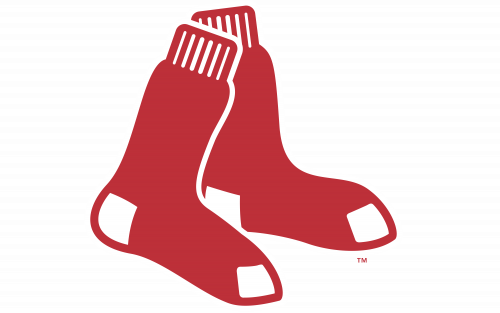
The Boston Red Sox sports logo is one of the most iconic emblems in Major League Baseball, characterized by its depiction of two red socks. This simple yet effective design conveys the team’s identity while maintaining a sense of tradition and nostalgia. The socks are stylized with white accents to mimic the appearance of actual athletic socks, lending a playful yet memorable aesthetic to the logo.
First introduced in 1908, the red socks imagery evolved from the team’s original uniforms, which prominently featured red stockings. The logo has since become a symbol of Boston’s baseball legacy, often accompanied by the team’s scripted wordmark in various iterations over the years. The current version emphasizes minimalism, allowing the socks to stand out as a standalone icon.
25. Cleveland Guardians Logo
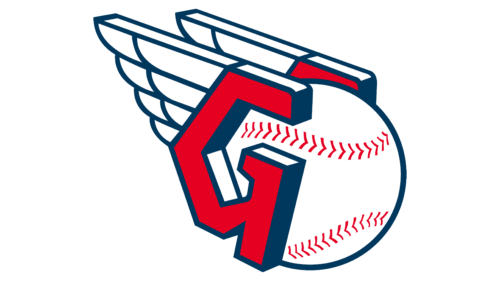
The Cleveland Guardians sports logo represents a bold new chapter for Cleveland’s baseball team, symbolizing progress while paying homage to the city’s heritage.
Reflecting on the logo’s launch, Paul Dolan, Cleveland Guardians’ owner, stated, “This new identity reflects our city’s history and what it means to stand for Cleveland. It’s about connection, pride, and moving forward together.”
The design centers on a baseball with wings, which are inspired by the iconic “Guardians of Traffic” statues that adorn Cleveland’s Hope Memorial Bridge. These Art Deco-inspired wings embody strength, speed, and forward motion, signifying the dynamic nature of the sport and the team’s aspirations.
The letter “G” is prominently incorporated into the logo, forming the structure of the wings and unifying the Guardians’ identity. The red, white, and blue color palette reflects the team’s traditional hues, bridging the past and the future while resonating with the broader American baseball tradition.
26. Penrith Panthers
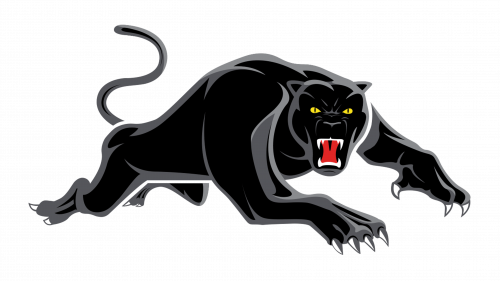
The Penrith Panthers sports logo embodies a fierce and dynamic representation of the team’s identity. The design features a sleek black panther in mid-pounce, with glowing yellow eyes, sharp claws, and an open mouth ready to strike. This aggressive posture symbolizes the team’s strength, agility, and determination, qualities synonymous with the Penrith Panthers’ performance on the rugby field.
The panther’s muscular build and streamlined form emphasize power and athleticism, while the black fur conveys mystery and dominance. The red tongue and sharp white teeth add contrast and highlight the intensity of the design, making it visually striking and memorable.
27. Lake Elsinore Storm Logo
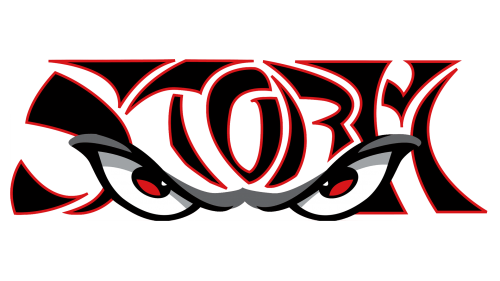
The Lake Elsinore Storm sports logo is a captivating design that emphasizes intensity and character. Dominated by a striking pair of piercing eyes embedded within the word “Storm,” the logo exudes a sense of mystery and determination. The eyes are shaded with red and black, giving a fiery and intimidating appearance, while the surrounding typography is dynamic and jagged, mimicking the chaos of an actual storm.
The bold use of red and black not only highlights the team’s fierce competitive spirit but also ensures the logo stands out among other designs. The symmetry in the lettering combined with the menacing eyes creates a powerful visual impact, symbolizing focus and resilience.
28. Birmingham Bulls Logo
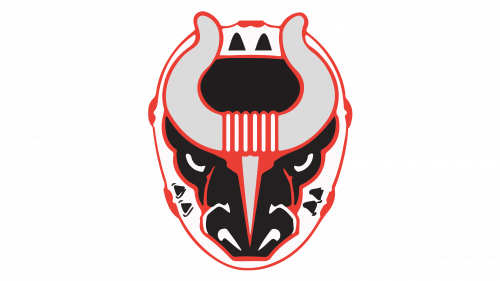
The Birmingham Bulls sports logo is a fierce and commanding design that exudes strength and intensity. It prominently features the face of a bull, framed with sharp, angular lines that add a modern and aggressive touch. The use of red, black, and white emphasizes power and determination, with the bull’s horns and piercing eyes drawing immediate attention. The symmetry of the design enhances its boldness and visual appeal.
The horns dominate the upper portion of the logo, adding a sense of intimidation and strength, while the angular patterns across the bull’s face contribute to a dynamic and structured appearance. This combination of elements portrays a sense of raw energy and discipline, aligning with the competitive spirit the team embodies.
29. Arizona Coyotes Logo
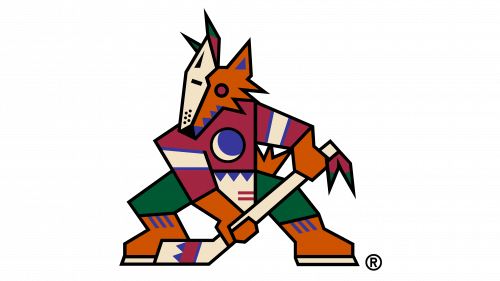
The Arizona Coyotes sports logo represents the NHL team based in Arizona. This logo, nicknamed the “Kachina Coyote,” was first introduced in 1996 when the franchise relocated from Winnipeg to Arizona. It was inspired by the rich cultural heritage of the Southwest, particularly Native American art and design.
The Coyotes’ organisation has often emphasized the importance of representing the region’s Native American heritage. When the logo returned as part of the team’s uniform in recent years, Coyotes Chief Brand Officer Rich Nairn said:
“The Kachina logo is more than a design—it’s a part of our identity as a team and a tribute to the culture and spirit of Arizona.”
The logo is a stylized depiction of a coyote, designed in a geometric and abstract manner, heavily influenced by Native American artistry. The figure features sharp, angular shapes to form the coyote’s body, with bold, contrasting colors like red, green, purple, and tan that evoke the Southwest desert’s natural hues. The coyote’s head is prominent, wearing a tribal-style mask, and the logo incorporates intricate patterns and symbols, creating a layered and textured aesthetic. The coyote holds a hockey stick, seamlessly connecting the cultural theme to the sport. The balanced use of symmetry and asymmetry, alongside deliberate negative space, gives the logo a dynamic yet cohesive appearance.
30. Wichita Thunder
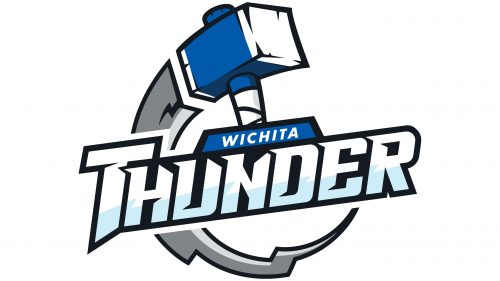
The Wichita Thunder sports logo represents the Wichita Thunder hockey team, which competes in the ECHL, a mid-level professional hockey league in North America. The team is based in Wichita, Kansas, and has been a part of the league since its founding in 1992.
The hammer, often associated with Norse mythology and the god Thor, was chosen to reflect resilience and strength, qualities celebrated by the team and its fan base.
The logo prominently features a stylized hammer, often associated with strength and power, placed diagonally behind the wordmark “Thunder.” The hammer’s angular design and bold blue coloring create a dynamic and modern visual appeal, evoking themes of energy and motion.
Surrounding the hammer and text is a circular saw blade, symbolising force and industrial grit, tying into the team’s hard-working, tenacious identity. The text “Thunder” is presented in a bold, gradient font with sharp edges and a metallic sheen, giving it a striking, electrifying effect. The word “Wichita” is subtly integrated in smaller text above the primary typography, maintaining the balance and hierarchy of the design.
31. England National Football Team Logo
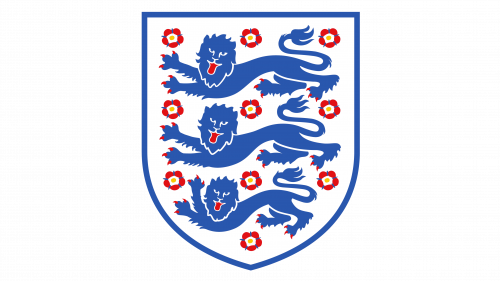
The England National Football Team sports logo, commonly referred to as the “Three Lions,” is a symbol of the national football team of England. The design traces its origins back to the royal arms of England, with the three lions initially adopted as a heraldic symbol by King Richard I (Richard the Lionheart) in the 12th century. The emblem represents English pride and tradition in the realm of sports, particularly in football.
Although the original designers are historically anonymous, the emblem’s significance has been celebrated by many figures in football. Gareth Southgate, the England manager, once commented on the emblem’s importance: “The Three Lions are a reflection of what we play for, who we represent, and the values of unity and resilience that define our nation.”
The logo is a shield containing three blue lions passant guardant, which means they are walking with their heads turned to face the viewer. The lions are surrounded by 10 red Tudor roses, a nod to the traditional English floral emblem. The use of a simple white background allows the vivid blue lions and red roses to stand out prominently, creating a clean and iconic visual. The lions are depicted with their claws extended, symbolizing strength and ferocity.
32. Espanyol Logo
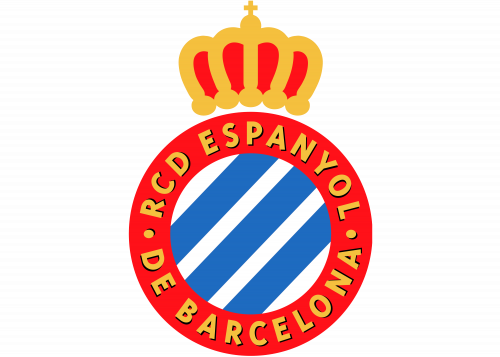
The Espanyol sports logo represents RCD Espanyol, a professional football club based in Barcelona, Spain. The club was founded in 1900, making it one of the oldest football clubs in La Liga history. The crest is a modern interpretation of the club’s identity, highlighting its Catalan heritage and historical roots.
Espanyol fans and club representatives often view the crest as a proud symbol of their unique identity within Catalonia, separate from their city rivals, FC Barcelona. Club president Joan Collet once remarked, “Our badge stands for tradition, passion, and a love for the sport that has endured for more than a century.”
The sports logo is circular in design, featuring a bold red outer ring with the club’s full name, “RCD Espanyol de Barcelona,” inscribed in uppercase gold letters. At the centre, a blue and white striped field represents the club’s official colors, surrounded by a white border for contrast. Topping the crest is a golden royal crown with intricate details, reflecting the “Real” (royal) title granted to the club in 1910 by King Alfonso XIII. The symmetry of the design and use of vibrant colors lend it a regal yet approachable aesthetic.
33. Hellas Verona Logo
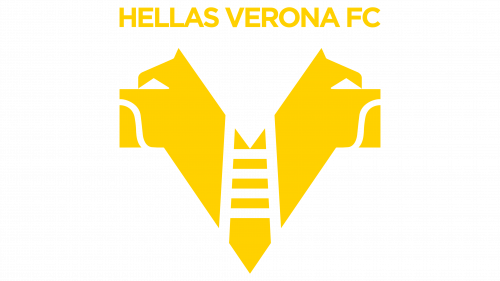
Former president Maurizio Setti mentioned, “The mastiffs represent loyalty and strength, qualities that define our team and inspire fans. The new logo design honors our heritage while looking to the future of Hellas Verona.”
The Hellas Verona sports logo represents Hellas Verona FC, a football club based in Verona, Italy. The club was established in 1903 and is a significant part of Italian football history. The logo encapsulates Verona’s local heritage and the club’s proud identity within Serie A.
The logo is minimalist and symmetrical, featuring two stylized yellow mastiff heads facing outward, symbolizing the city’s historical guardians. These mastiffs are integrated into a bold “V” shape that represents both Verona and victory. Below the mastiffs is a ladder-like design, paying homage to the city’s architectural history.
34. Babolat
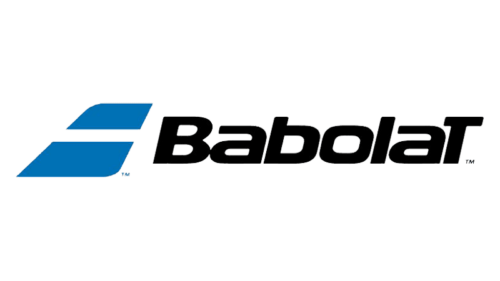
The Babolat sports logo represents Babolat, a French company renowned for its tennis, badminton, and squash equipment. Founded in 1875 in Lyon, France, Babolat is the oldest company specializing in racket sports, holding a prominent place in the industry worldwide.
Eric Babolat, the CEO of Babolat, has stated, “Our logo is a representation of our heritage and commitment to innovation in the world of sports. It’s a symbol of the excellence and precision we aim to bring to every athlete who chooses our brand.”
The logo incorporates a dynamic design with clean, modern elements. It features a bold, italicized sans-serif typeface, emphasizing speed and energy—key characteristics of racket sports. The distinctive blue and white stripes to the left symbolize movement and precision, visually mimicking the strings of a racket. The color blue conveys trust and reliability, while the angled design adds a sense of motion and athleticism.
35. Metz Logo
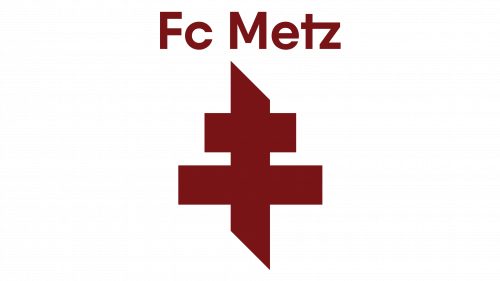
The Metz sports logo represents FC Metz, a French professional football club based in Metz, Lorraine. The club has a long-standing history, having been founded in 1932, and competes in the French football league system.
The FC Metz logo features a minimalistic design dominated by a burgundy color scheme, reflecting the club’s official colors. The emblem showcases a simplified Lorraine Cross, a regional symbol representing the club’s geographical and cultural roots. The “Fc Metz” text is presented in a clean sans-serif typeface, balancing modernity with tradition.
36. Head

The HEAD sports logo represents HEAD Sport GmbH, an international sports equipment and clothing company. Established in 1950, the brand is renowned for its innovations in skiing, tennis, and other sports, with a global presence in the professional and recreational sports industries. As a sponsor of the best sportsmen active today, HEAD is a business that is constantly seen both in print and digital, in many campaigns with its athletes.
The Head logo features a modern and minimalist design, with a distinctive arc resembling a stylized head or racquet frame. The bold sans-serif typography emphasizes strength and reliability, while the clean, symmetrical lines of the emblem convey innovation and precision. The black-and-white color scheme enhances its versatility and ensures high visibility across various media.
37. Prince

The Prince logo represents Prince Global Sports, an American sporting goods company founded in 1970. Tennis star Andre Agassi, who played with Prince racquets during his early career, remarked, “Prince was ahead of its time in revolutionising tennis equipment, giving players tools that matched their ambitions.” The brand is best known for its innovative contributions to tennis equipment, including the oversized tennis racquet. Similar to Wilson (below), the Prince business logo has been a common sight at sponsored events, as the best sportsmen will sport their logo print on sponsored merchandise.
The Prince logo features a bold, lowercase font in a vibrant green hue, signifying energy, growth, and excellence in sports. The rounded edges of the typography convey approachability, while the italicized style represents speed and forward momentum. The clean and minimalistic design ensures adaptability across various branding platforms.
38. Wilson
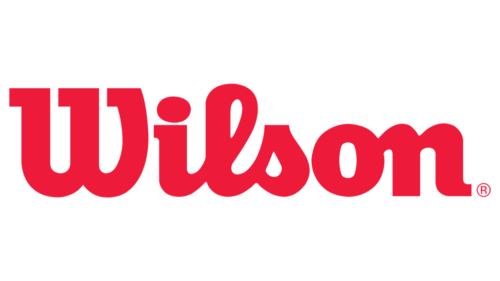
The Wilson logo represents Wilson Sporting Goods, a Chicago-based company established in 1914. Wilson is globally recognised for producing high-quality sports equipment, particularly for tennis, basketball, and football. This logo is often sported on the best sportsmen due to the regular sponsorship of the brand to athletic events.
The Wilson logo features a bold, custom sans-serif typeface in red, symbolizing energy, passion, and excellence. The rounded contours of the letters create an approachable and timeless aesthetic, while the slightly condensed spacing ensures readability and brand recall.
39. K Swiss

The K-Swiss logo represents the iconic sportswear brand founded in 1966 by Swiss brothers Art and Ernie Brunner. The company, based in California, is renowned for its tennis shoes and classic designs.
The K-Swiss logo features a shield design with alternating red and blue diagonal stripes, symbolizing strength and heritage. Below the shield, the brand name is displayed in bold, geometric sans-serif typography, ensuring clarity and a modern appeal. The use of primary colors evokes trust, confidence, and energy.
40. Slazenger

The Slazenger logo represents the iconic British sports logo equipment brand founded in 1881 by Ralph and Albert Slazenger. Known for its tennis and golf equipment, Slazenger has a rich heritage in competitive sports and is headquartered in England.
The logo features a sleek silhouette of a leaping panther, symbolizing agility, power, and grace. The panther is positioned above the brand name, written in an elegant serif typeface that conveys tradition and sophistication. The black-and-white color scheme emphasizes timelessness and versatility, ensuring visibility across diverse branding mediums.
41. Gamma

The Gamma logo represents Gamma Sports, a company renowned for its innovative tennis strings, grips, and racquet technologies. Headquartered in Pittsburgh, Pennsylvania, Gamma is a trusted name among tennis and pickleball enthusiasts for its high-performance products.
The Gamma logo incorporates a bold, modern sans-serif typeface, emphasizing strength and reliability. The red circular icon with a stylized “G” inside serves as a focal point, combining dynamic curves with angular cuts to signify motion and precision. The monochromatic black lettering paired with the red icon enhances brand visibility and recognition for sports logos.
42. Asics

Kiyomi Wada, a key designer at ASICS, once explained, “The logo embodies movement and the harmony of body and mind.”
The Asics logo represents the globally recognized Japanese sportswear company Asics, headquartered in Kobe, Japan. Known for its high-quality athletic footwear, apparel, and equipment, Asics stands for “Anima Sana In Corpore Sano,” meaning “A Sound Mind in a Sound Body.”
The ASICS logo features a dynamic and curved emblem resembling a swirling “A,” which symbolizes motion, energy, and athleticism. The clean, bold, sans-serif typeface of the wordmark sport logo complements the emblem, portraying strength and modernity. The deep blue color conveys trust, dependability, and professionalism, aligning with the brand’s values of innovation and quality in sports performance.
43. Yonex
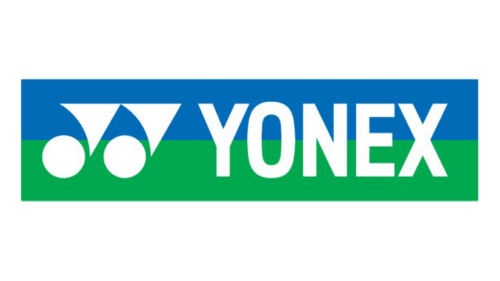
The Yonex logo represents Yonex Co., Ltd., a Japanese sports equipment company known worldwide for its badminton, tennis, and golf gear. The brand is headquartered in Tokyo and has been a dominant force in professional and amateur sports since its founding in 1946.
The Yonex logo features two prominent geometric symbols: a blue triangle and a green semi-circle, accompanied by a solid sans-serif wordmark. The geometric shapes signify shuttlecocks, tying directly to Yonex’s badminton legacy. The colors blue and green evoke trust, growth, and vitality, while the clean typography emphasises the brand’s straightforward and innovative approach. The two-tone color palette is strategically designed to stand out on equipment and apparel.
44. Joola

The Joola logo represents Joola, a German table tennis equipment manufacturer established in 1952. The brand is known for producing high-quality table tennis tables, rackets, and accessories and has been a staple in professional and amateur table tennis tournaments globally.
The Joola logo consists of a bold, modern triangular icon paired with a clean sans-serif wordmark. The triangular design, with its angular cuts and smooth lines, symbolizes precision and dynamic motion, resonating with the fast-paced nature of table tennis. The monochromatic black color scheme conveys professionalism, simplicity, and timelessness. The typography complements the sharp icon with a rounded geometric style for better balance and readability.
Final Words
As the world of sports changes, these logos evolve too. Many teams adopt modern aesthetics while staying rooted in their origins. Whether you’re drawn to the history of a logo or its visual impact, one thing is certain: these emblems connect us to the energy and excitement of sports in ways no other design can.
Take a page from the brilliance of the Milwaukee Brewers’ ball-in-glove logo, a design so simple yet so genius it makes people look twice. Arvin AI’s Logo Designer offers you the tools to create logos that spark curiosity, admiration, and brand loyalty. Explore your creative side now!
FAQ
What is the coolest sports logo?
This is subjective and depends on personal preferences. Some might vote for the fierce “Kachina Coyote” of the Arizona Coyotes for its cultural artistry, while others might prefer the classic elegance of the New York Yankees’ interlocking “NY.” The Chicago Bulls logo also stands out for its aggressive and timeless design.
What is the most valuable sports logo?
Logos of teams like the New York Yankees, Dallas Cowboys, and Manchester United are among the most valuable, representing billions of dollars in brand worth due to their global fanbase, merchandise sales, and cultural impact.
What makes a logo look sporty?
A sporty logo typically incorporates elements like motion, energy, and bold design. Clean lines, dynamic typography, vibrant color schemes, and symbols associated with competition (like balls, wings, or claws) are common features. These elements evoke speed, power, and passion, essential traits of sports.
What pro sports team has a crown in its logo design?
The Los Angeles Kings in the NHL and Real Madrid in soccer both feature crowns in their logos.
What does the Golden State Warriors logo mean?
The logo features the eastern span of the San Francisco-Oakland Bay Bridge, rather than the Golden Gate Bridge. This focus reflects a connection to the Bay Area, where the team has played over the years.
Why is the Kansas City Chiefs logo an arrowhead?
It is an arrowhead as a reference to the North American Heritage associated with the region. The name “Chiefs” was inspired by Kansas City Mayor Harold Roe Bartle, who was nicknamed “Chief”: due to his involvement with the Boy Scouts of Mic-O-Say.
Who designed the New England Patriots logo?
It was designed by Ken Loh.
What are the stars on the Los Angeles Lakers’ logo?
The Los Angeles Lakers’ logo features stars occasionally to represent their championship victories. For example, a yellow star was placed on the original logo to mark Minneapolis, the team s original home, as well as to signify each championship win.


